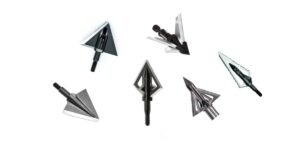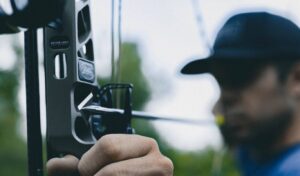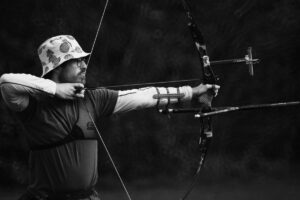Turkey Season is close! Are you looking to add a new quarry to your bowhunting adventures this year? If so, look no further than the wild turkey. These wary birds offer unique and challenging bowhunts few other quarries can match.
To be successful when bow hunting turkeys, start by doing your homework. Scouting is vital, so get out there and find the areas where turkeys are most likely to be found. Once you’ve located some prime spots, set up ground blinds in these areas well before the season opener.
Contents (Jump to Topic)
TogglePractice Shooting in Different Positions
Many bowhunters struggle to draw their bows while seated or kneeling. This can be due to several reasons, such as a weak back, poor shooting form, or incorrect stance. If you find yourself struggling to draw your bow while seated or kneeling, try reducing your draw weight to something more manageable. You can also try shooting from a different position until you feel comfortable and confident. Remember, practice makes perfect!
Practice Drawing and Shooting while Seated or Kneeling
Practice becoming more proficient. Experiment with different positions to find the most comfortable and give you the best shot. Unlike deer, turkey hunting is done from the ground. So, get comfortable and be ready for the challenge come turkey season. Remember, practice makes perfect!
Experiment with Different Shooting Positions
Get comfortable shooting from different positions. Again, practice is the key to success.
Reduce your Draw Weight
If you can’t draw your bow from a seated or kneeling position, try reducing your draw weight.
Clothes and Gear
Practice with your bowhunting clothes and gear on to get used to it. Kneeling in your hunting gear might be different from kneeling in your everyday clothes. Get used to how it all feels so you’re not dealing with any surprises on the big day.
Shot Placement – Turkey’s Vitals
A turkey’s vital area, including its heart and lungs, is obviously much smaller than a deer’s. Turkey’s vitals are about the size of a grapefruit. Their location also differs, so check online images that show a gobbler’s vitals when it’s resting and strutting.
Bowhunters, you’ve got to know the turkey vitals to have a better chance of making an effective shot. This means knowing where they are and where to aim when resting and strutting.
Understand the Anatomy of a Turkey
Get to know the location of a turkey’s vital area before taking your shot. Knowing where to aim will give you a better chance of making an effective shot.
Know the Location and Size of their Vital Organs
The heart and lungs of a turkey are about the size of a grapefruit. Know where to aim when they are resting or strutting to increase your chances of making an effective shot.
Know where to Aim
Shot placement is critical when bowhunting turkeys. You’ve got to place your arrow in the right spot to take them down. For more information on shot placement, check out this article: https://www.mathewsinc.com/turkey-shot-placement/.
Scouting is Essential
Scouting is the key to putting yourself in the best position to intercept gobblers. Learn how birds move about on the landscape and use trail cameras to supplement your scouting. The better you know the terrain and the movements of the game, the easier it will be to call them within range.
A well-planned scouting trip will also help you determine the best setup locations for your hunt. Scouting can even help you bag a bird on an opening morning without ever calling to one. Simply slip into the pre-scouted area where you know there are turkeys. Ideally, your ground blind is already set up.
Key takeaways:
• Scouting is the key to putting yourself in the best position
• Scout your area and use trail cameras
• With scouting, you will know where animals are and how they move about
Take into consideration at what time of the day each location is most active – and how you can get there without spooking turkeys.
Use Decoys
If you can use decoys, you place them at a known distance to help pinpoint the distance. When you set up your decoys, you want to put them in a way that will entice the turkey to come close.
A close distance is ideal for shot placement and effectivity. But don’t forget that turkeys’ eyes are phenomenally good. Keep that in mind when you’re drawing your bow. Every movement should be concealed as much as possible.
- Decoys can help pinpoint the distance to a turkey
- They can also entice the turkey to come close
- Don’t forget to check if they’re legal in your area
Improve your Chances with a Ground Blind

You want to conceal the draw and other movements as much as possible. A ground blind does just that. It also helps keep you hidden from the turkeys’ vision.
Ground blinds come in a variety of shapes and sizes. You want to make sure to get one that will fit the terrain you will be hunting in and that allows you to comfortably draw your bow.
- Ground blinds will help you cover your movements
- Blinds are available in different sizes
Conclusion
If you want to improve your chances of taking down a turkey with a bow, consider using the tips we’ve provided. Scouting will help put you in the best position to intercept gobblers, and ground blinds can conceal your movements so that you don’t spook them. If legally allowed, using decoys can also entice the turkey to come close. Decoys can also help pinpoint the distance to a turkey.
Thanks for reading! Remember to always check with your local hunting regulations to ensure that you are following all the applicable rules and regulations. Happy hunting!






